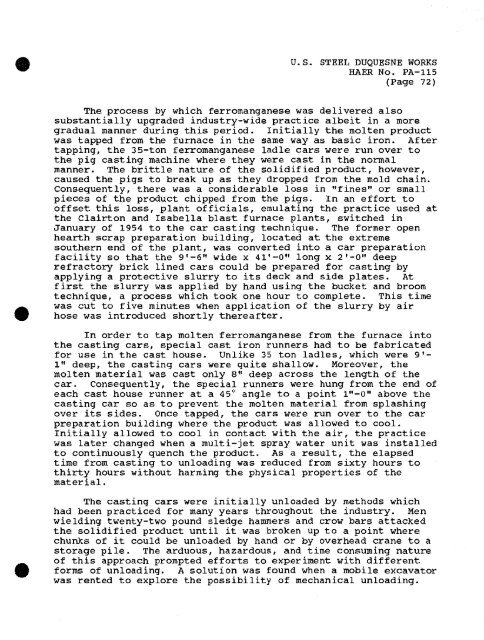pa1778data.pdf
pa1778data.pdf
pa1778data.pdf
Create successful ePaper yourself
Turn your PDF publications into a flip-book with our unique Google optimized e-Paper software.
U.S. STEEL DUQUESNE WORKS<br />
HAER No. PA-115<br />
(Page 72)<br />
The process by which ferromanganese was delivered also<br />
substantially upgraded industry-wide practice albeit in a more<br />
gradual manner during this period. Initially the molten product<br />
was tapped from the furnace in the same way as basic iron. After<br />
tapping, the 35-ton ferromanganese ladle cars were run over to<br />
the pig casting machine where they were cast in the normal<br />
manner. The brittle nature of the solidified product, however,<br />
caused the pigs to break up as they dropped from the mold chain.<br />
Consequently, there was a considerable loss in "fines" or small<br />
pieces of the product chipped from the pigs. In an effort to<br />
offset this loss, plant officials, emulating the practice used at<br />
the Clairton and Isabella blast furnace plants, switched in<br />
January of 1954 to the car casting technique. The former open<br />
hearth scrap preparation building, located at the extreme<br />
southern end of the plant, was converted into a car preparation<br />
facility so that the 9'-6" wide x 41*-0" long x 2'-0" deep<br />
refractory brick lined cars could be prepared for casting by<br />
applying a protective slurry to its deck and side plates. At<br />
first the slurry was applied by hand using the bucket and broom<br />
technique, a process which took one hour to complete. This time<br />
was cut to five minutes when application of the slurry by air<br />
hose was introduced shortly thereafter.<br />
In order to tap molten ferromanganese from the furnace into<br />
the casting cars, special cast iron runners had to be fabricated<br />
for use in the cast house. Unlike 35 ton ladles, which were 9'-<br />
1" deep, the casting cars were quite shallow. Moreover, the<br />
molten material was cast only 8" deep across the length of the<br />
car. Consequently, the special runners were hung from the end of<br />
each cast house runner at a 45° angle to a point l"-0" above the<br />
casting car so as to prevent the molten material from splashing<br />
over its sides. Once tapped, the cars were run over to the car<br />
preparation building where the product was allowed to cool.<br />
Initially allowed to cool in contact with the air, the practice<br />
was later changed when a multi-jet spray water unit was installed<br />
to continuously quench the product. As a result, the elapsed<br />
time from casting to unloading was reduced from sixty hours to<br />
thirty hours without harming the physical properties of the<br />
material.<br />
The casting cars were initially unloaded by methods which<br />
had been practiced for many years throughout the industry. Men<br />
wielding twenty-two pound sledge hammers and crow bars attacked<br />
the solidified product until it was broken up to a point where<br />
chunks of it could be unloaded by hand or by overhead crane to a<br />
storage pile. The arduous, hazardous, and time consuming nature<br />
of this approach prompted efforts to experiment with different<br />
forms of unloading. A solution was found when a mobile excavator<br />
was rented to explore the possibility of mechanical unloading.

















